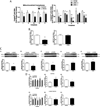Targeting mitochondria to restore failed adaptation to exercise in diabetes
- PMID: 24646223
- PMCID: PMC4103429
- DOI: 10.1042/BST20130283
Targeting mitochondria to restore failed adaptation to exercise in diabetes
Abstract
Our translational research group focuses on addressing the problem of exercise defects in diabetes with basic research efforts in cell and rodent models and clinical research efforts in subjects with diabetes mellitus. CREB (cAMP-response-element-binding protein) regulates cellular differentiation of neurons, β-cells, adipocytes and smooth muscle cells; it is also a potent survival factor and an upstream regulator of mitochondrial biogenesis. In diabetes and cardiovascular disease, CREB protein content is decreased in the vascular media, and its regulation in aberrant in β-cells, neurons and cardiomyocytes. Loss of CREB content and function leads to decreased vascular target tissue resilience when exposed to stressors such as metabolic, oxidative or sheer stress. This basic research programme set the stage for our central hypothesis that diabetes-mediated CREB dysfunction predisposes the diabetes disease progression and cardiovascular complications. Our clinical research programme revealed that diabetes mellitus leads to defects in functional exercise capacity. Our group has determined that the defects in exercise correlate with insulin resistance, endothelial dysfunction, decreased cardiac perfusion and diastolic dysfunction, slowed muscle perfusion kinetics, decreased muscle perfusion and slowed oxidative phosphorylation. Combined basic and clinical research has defined the relationship between exercise and vascular function with particular emphasis on how the signalling to CREB and eNOS [endothelial NOS (nitric oxide synthase)] regulates tissue perfusion, mitochondrial dynamics, vascular function and exercise capacity. The present review summarizes our current working hypothesis that restoration of eNOS/NOS dysfunction will restore cellular homoeostasis and permit an optimal tissue response to an exercise training intervention.
Figures



References
-
- Regensteiner JG, Sippel J, McFarling ET, Wolfel EE, Hiatt WR. Effects of non-insulin-dependent diabetes on oxygen consumption during treadmill exercise. Med Sci. Sports Exerc. 1995;27:661–667. - PubMed
-
- Brandenburg SL, Reusch JE, Bauer TA, Jeffers BW, Hiatt WR, Regensteiner JG. Effects of exercise training on oxygen uptake kinetic responses in women with type 2 diabetes. Diabetes Care. 1999;22:1640–1646. - PubMed
Publication types
MeSH terms
Substances
Grants and funding
- T32 DK063687/DK/NIDDK NIH HHS/United States
- P01HL014985/HL/NHLBI NIH HHS/United States
- R01 DK064741/DK/NIDDK NIH HHS/United States
- T32 HL007171/HL/NHLBI NIH HHS/United States
- UL1 RR025780/RR/NCRR NIH HHS/United States
- T32 DK007446/DK/NIDDK NIH HHS/United States
- T32HL007171/HL/NHLBI NIH HHS/United States
- P01 HL014985/HL/NHLBI NIH HHS/United States
- I01 BX001837/BX/BLRD VA/United States
- K12 HD057022/HD/NICHD NIH HHS/United States
- UL1RR025780/RR/NCRR NIH HHS/United States
- I01 CX001532/CX/CSRD VA/United States
- I01 BX002046/BX/BLRD VA/United States
- R01-DK064741/DK/NIDDK NIH HHS/United States
- UL1 TR001082/TR/NCATS NIH HHS/United States
LinkOut - more resources
Full Text Sources
Other Literature Sources
Medical

